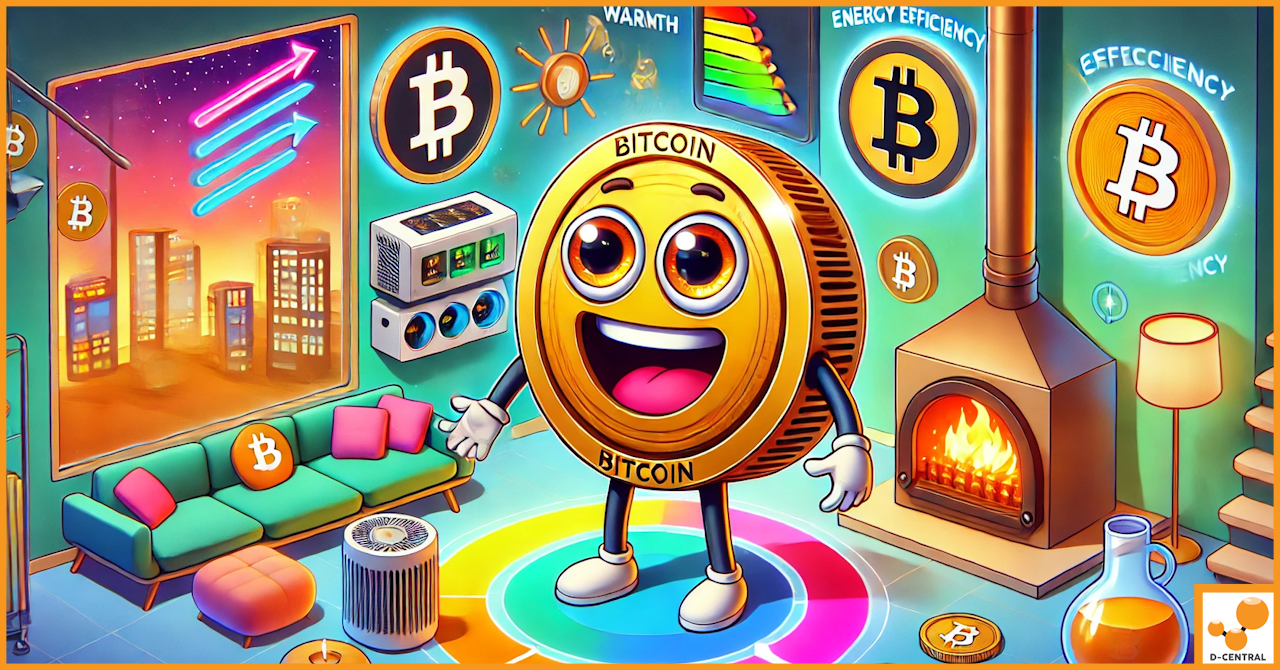
Maximize Efficiency with Dual-Purpose Miners for Bitcoin and Home Heating
Discover how D-Central’s innovative dual-purpose miners can transform your living space, combining Bitcoin mining with efficient home heating. Maximize your
4479 Desserte Nord Autoroute 440, Laval, QC H7P 6E2

In the realm of digital currencies, Bitcoin stands as a pioneering force, driving a revolution in how we perceive and transact value. However, as with any groundbreaking technology, it faces challenges. One of the most pressing is scalability. While traditional payment systems like Visa can handle thousands of transactions per second (TPS), Bitcoin’s TPS has historically lagged. But why is this the case, and what solutions are on the horizon?
Blockchain, the underlying technology of Bitcoin, is lauded for its decentralized and secure nature. Every transaction requires verification from a majority of nodes, ensuring trustworthiness. However, this very feature becomes a bottleneck when scaling.
Technically, one might think increasing the block size or reducing the block time could be solutions. However, these come with their own set of challenges. Larger blocks could lead to centralization, with only powerful nodes being able to process them. On the other hand, reducing block time could increase the risk of forks in the network.
Moreover, the relay time between nodes in the Bitcoin network poses another challenge. As the network grows, ensuring that every node receives and processes every transaction becomes increasingly complex.
The Lightning Network (LN) emerged as a promising solution to Bitcoin’s scalability challenges. Conceived by Joseph Poon and Thaddeus Dryja in 2015, the LN was designed to operate as a second-layer protocol over Bitcoin’s blockchain. The primary objective was to facilitate faster transactions without congesting the main blockchain. Over the years, the LN has seen significant development, with increasing adoption and enhancements to its infrastructure.
Unlike traditional Bitcoin transactions that are recorded on the main blockchain, the LN operates off-chain. It introduces the concept of payment channels, allowing users to transact multiple times without broadcasting to the blockchain. Only when the channel is opened (initial transaction) and closed (final settlement) are transactions recorded on the main blockchain. This mechanism drastically reduces the load on the main chain, enabling rapid and high-volume transactions.
One of the standout features of the LN is its ability to handle micropayments efficiently. Traditional Bitcoin transactions could become uneconomical for small amounts due to transaction fees. However, with LN’s bidirectional payment channels, users can send and receive minute amounts with minimal fees. These channels are “bidirectional” because both parties can transact in either direction, adjusting their respective balances.
https://twitter.com/Excellion/status/1456088664132440069/
The Lightning Network, with its innovative approach to scalability and transaction efficiency, holds the potential to revolutionize how we perceive Bitcoin transactions. Its emphasis on micropayments and rapid settlements makes it a pivotal tool in the broader adoption of Bitcoin.
VISA, one of the world’s leading payment processing networks, operates on a centralized infrastructure. With its roots dating back to the 1950s, VISA has established a robust and reliable system that handles an average of 1,700 transactions per second, with the capability to process over 65,000 transaction messages every second. Its vast infrastructure is supported by data centers located worldwide, ensuring uninterrupted service. VISA’s user base is colossal, with billions of cards issued globally, accepted by tens of millions of merchants in more than 200 countries and territories.
In contrast to VISA’s centralized model, the Lightning Network operates on a decentralized framework. At its core are the Lightning channels – private, off-chain pathways that allow users to transact without recording every transaction on the Bitcoin blockchain. These channels can remain open indefinitely, facilitating numerous transactions between parties. The true power of these channels lies in their ability to operate off-chain, only interacting with the main blockchain when opening or closing a channel. This design significantly reduces transaction fees and speeds up processing times, making microtransactions economically viable.
VISA’s transaction process involves a series of steps, starting with pre-authorization. When a user swipes their card, VISA checks the account for sufficient funds or credit. This pre-authorization ensures that the transaction will be completed once the merchant processes it. Only after this check does the actual fund transfer occur, often taking a couple of days for settlement.
The Lightning Network, on the other hand, operates differently. Since it functions off-chain, there’s no need for pre-authorization in the traditional sense. When two parties transact over a Lightning channel, they adjust their respective balances within the channel. The funds are already locked in the channel, ensuring instant and secure transactions. It’s only when the channel is closed that the final balances are settled on the main blockchain.
In essence, while VISA offers a tried-and-tested centralized payment solution with a vast user base, the Lightning Network introduces a decentralized, rapid, and cost-effective alternative. The innovative design of the Lightning Network, especially its off-chain transaction approach, positions it as a formidable contender in the evolving landscape of digital payments.
In early 2019, the Bitcoin community witnessed a unique social experiment known as the “Lightning Torch.” This initiative was designed to showcase the capabilities of the Lightning Network, particularly its ability to handle fast and low-cost transactions. The experiment involved passing a “torch” – a payment made using the Lightning Network – from one participant to another. Each participant added a small amount of Bitcoin to the payment before passing it on, effectively increasing the “torch’s” value with each transaction.
The Lightning Torch garnered significant attention, not just from the crypto community but also from mainstream figures. Notable participants included:
The torch traveled across continents, passing through over 50 countries, and was held by more than 280 participants before reaching its final destination. The experiment concluded with a charitable donation, demonstrating the potential of the Lightning Network for social good.
Beyond the Lightning Torch experiment, the Lightning Network has found various real-world applications:
The Lightning Network, with its innovative design and real-world applications, stands as a testament to the evolving nature of digital payments. Its successful integration into various sectors underscores its potential to reshape the financial landscape.
Andreas M. Antonopoulos, a globally recognized Bitcoin advocate, educator, and author, has shared insightful perspectives on the Lightning Network over the years. He views the Lightning Network as a crucial layer-2 solution that addresses Bitcoin’s scalability challenges without compromising its decentralized ethos. Antonopoulos often emphasizes the network’s potential to facilitate micropayments, which could revolutionize online content monetization and other sectors. He also highlights the importance of off-chain solutions like the Lightning Network in maintaining Bitcoin’s security and decentralization while catering to a growing user base.
One of the unique design features of the Lightning Network is its penalty mechanism, which ensures that all participants act honestly. In the event that a participant tries to cheat by broadcasting an outdated transaction state, the other party can claim the entire balance of the channel as a penalty. This “punitive” system acts as a strong deterrent against malicious actions. By putting the funds at risk for dishonest actors, the Lightning Network ensures that it’s more profitable for participants to cooperate than to attempt deceit.
Time-based script extensions, often referred to as “timelocks,” play a pivotal role in the Lightning Network’s operation. These timelocks ensure that funds within a payment channel are temporarily “locked up” and can’t be spent until a specified condition is met or a certain time has passed.
There are two primary types of timelocks used in the Lightning Network:
Both CSV and CLTV are vital in ensuring the security and functionality of the Lightning Network. They provide the necessary safeguards that allow for rapid, off-chain transactions while ensuring that funds remain secure and disputes can be resolved fairly.
The design and technical intricacies of the Lightning Network underscore its potential as a transformative layer-2 solution for Bitcoin. By addressing scalability challenges and ensuring secure, rapid transactions, the Lightning Network paves the way for broader cryptocurrency adoption and integration into everyday financial systems.
The Lightning Network shines when it comes to facilitating micropayments. Traditional blockchain transactions, especially on networks like Bitcoin, can become uneconomical for small amounts due to associated transaction fees. However, the Lightning Network’s design allows for the efficient transfer of minuscule amounts of Bitcoin. This granularity opens up a plethora of possibilities, from pay-per-view content models to micro-donations, enabling new monetization strategies and business models that were previously infeasible.
Privacy is a cornerstone of the Lightning Network. Unlike on-chain Bitcoin transactions, which are recorded on a public ledger and can be viewed by anyone, Lightning Network transactions are primarily off-chain and private. Only the opening and closing of channels are recorded on the blockchain. The intermediate transactions, which can number in the thousands for a single channel, remain known only to the parties involved. This ensures a higher degree of financial privacy for users, aligning with the cypherpunk ethos of personal freedom and privacy.
One of the most touted benefits of the Lightning Network is its speed. Traditional Bitcoin transactions require confirmations, which, depending on network congestion, can take significant time. In contrast, Lightning Network transactions are almost instantaneous, regardless of the network’s state. This speed is achieved by bypassing the blockchain for intermediate transactions, making the process incredibly efficient. Such rapidity is especially beneficial for scenarios requiring quick settlements, like point-of-sale transactions in retail settings.
While traditional blockchains have a limit to the number of transactions they can process per second (TPS), the Lightning Network, in theory, has the potential for unlimited TPS. Since most transactions occur off-chain and directly between parties, the only limiting factor is the speed of the underlying hardware and network connections. This scalability solution ensures that as adoption grows and more users join the network, the Lightning Network can handle the increased load without compromising on speed or efficiency.
While bidirectional payment channels in the Lightning Network facilitate rapid and repeated transactions between two parties, they also introduce a level of complexity. For a user to transact with another user, a direct or indirect channel must exist between them. If Alice wants to send funds to Bob, but they don’t have a direct channel open, the payment must route through multiple intermediate channels. This necessity can sometimes lead to inefficiencies, especially if the network topology is not well-connected or if suitable routes with sufficient liquidity are not available.
To ensure the security of off-chain transactions, the Lightning Network introduces the concept of “watchtowers.” These are third-party services that monitor the blockchain on behalf of users to prevent fraud. If a malicious actor tries to close a channel using an outdated transaction (to potentially claim more funds), the watchtower can detect this and penalize the actor. While watchtowers enhance security, they also introduce new challenges:
The decentralized nature of the Lightning Network means that not every participant is directly connected to every other participant. When two users lack a direct payment channel between them, transactions must “hop” through multiple intermediate channels. This routing process can present challenges:
While the Lightning Network offers numerous advantages, it’s essential to understand its limitations and challenges. Addressing these issues is crucial for the continued growth and widespread adoption of this innovative layer-2 solution.
The Lightning Network, with its innovative design and technical prowess, stands at the forefront of blockchain scalability solutions. Its ability to facilitate rapid, low-cost transactions without burdening the main Bitcoin blockchain is nothing short of revolutionary. By addressing some of the most pressing challenges faced by Bitcoin, such as transaction speed and scalability, the Lightning Network not only enhances the utility of Bitcoin but also paves the way for its broader adoption in everyday transactions.
As the financial landscape continues to evolve, the integration of decentralized systems like Bitcoin becomes increasingly crucial. The Lightning Network, as a layer-2 solution, plays a pivotal role in this integration. Its potential to handle micropayments efficiently, coupled with its rapid transaction capabilities, positions it as a game-changer in the world of digital payments. As more businesses and individuals recognize the benefits of the Lightning Network, its adoption is set to soar, further solidifying Bitcoin’s place in the global financial ecosystem.
At D-Central Technologies, we are committed to staying at the cutting edge of Bitcoin and blockchain innovations. We recognize the transformative potential of the Lightning Network and are dedicated to providing our clients with the latest insights, services, and solutions in the Bitcoin mining industry. Whether you’re a seasoned Bitcoiner or new to the world of cryptocurrencies, D-Central is here to guide and support you.
What is the Lightning Network?
The Lightning Network (LN) is a second-layer protocol that operates on top of a blockchain. It was conceived by Joseph Poon and Thaddeus Dryja in 2015 as a solution to Bitcoin’s scalability challenges, designed to enable faster transactions without congesting the main blockchain.
How does the Lightning Network improve Bitcoin’s scalability?
The Lightning Network improves Bitcoin’s scalability by enabling transactions to take place off-chain via payment channels. These payment channels allow users to transact multiple times without broadcasting to the blockchain. Transactions are only recorded on the main blockchain when the channel is opened (initial transaction) and closed (final settlement).
What are micropayments and how does the Lightning Network handle them?
Micropayments are small amounts of money, typically sent over the Internet. The Lightning Network is especially adept at handling micropayments, allowing users to send and receive small amounts with minimal fees thanks to the use of bidirectional payment channels.
What is the process of opening, transacting, and closing payment channels on the Lightning Network?
Opening a Lightning Network channel involves a transaction on the main blockchain, while transacting in the channel involves updating the balance sheet, reflecting the new balances of both parties, only known to them. When users decide to close the channel, the final balance sheet is broadcasted to the main blockchain.
What is the Lightning Network’s approach to privacy?
The Lightning Network ensures a high degree of financial privacy as transactions are mainly off-chain and private. Only the opening and closing of channels are recorded on the blockchain. The intermediate transactions remain known only to the parties involved.
What is the role of watchtowers in the Lightning Network?
Watchtowers are third-party services that monitor the blockchain on behalf of users to prevent fraud. They enhance security, but they also introduce trust, privacy, and cost considerations.
What applications have the Lightning Network found in real-world usage?
The Lightning Network has found various applications in micropayments, instant settlements, cross-chain swaps, gaming, and retail, enabling new monetization strategies and business models.
What limitations and challenges does the Lightning Network face?
The Lightning Network, while advantageous, faces complexity in managing bidirectional payment channels, privacy, and trust issues with watchtowers, and routing challenges due to liquidity issues and increased fees for multi-hop transactions.
How can I get involved in Bitcoin mining or learn more about the Lightning Network?
You can get involved by reaching out to D-Central Technologies Inc. They are dedicated to providing clients with the latest insights, services, and solutions in the Bitcoin mining industry.
DISCLAIMER: D-Central Technologies and its associated content, including this blog, do not serve as financial advisors or official investment advisors. The insights and opinions shared here or by any guests featured in our content are provided purely for informational and educational purposes. Such communications should not be interpreted as financial, investment, legal, tax, or any form of specific advice. We are committed to advancing the knowledge and understanding of Bitcoin and its potential impact on society. However, we urge our community to proceed with caution and informed judgment in all related endeavors.
Related Posts

Discover how D-Central’s innovative dual-purpose miners can transform your living space, combining Bitcoin mining with efficient home heating. Maximize your

Quebec is renowned for its expansive hydroelectric capabilities, courtesy of its vast natural water resources. The province’s energy infrastructure is

Braiins OS is a fully open-source, Linux-based operating system for cryptocurrency mining. Developed by the team behind Slush Pool, the